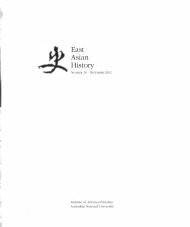Observations from a Film - (Miriam Lang) (PDF ... - East Asian History
Observations from a Film - (Miriam Lang) (PDF ... - East Asian History
Observations from a Film - (Miriam Lang) (PDF ... - East Asian History
- No tags were found...
Create successful ePaper yourself
Turn your PDF publications into a flip-book with our unique Google optimized e-Paper software.
TRADITIONAL MUSICIANS IN CONTEMPORARY CHINA171Transfonned by the reworking (both rhythmic and melodic) of thethemes, the chromatic tonalities and the orchestration, Ou's melody is notinunediately recognizable until the solo flute brings it unmistakably to theaudience's attention. Significantly, in the flute score of the first eight bars ofOu Laoshu's melody as it is used in Yunzhi's composition, the ornamentationis fully written out-unlike the score for Ou Laoshu's original theme, wherethe ornamentation is added at will by the perfonner.Guanzai turns off the televised perfonnance of the composition beforethe end, and so the film audience does not hear the final appropriations ofOu Laoshu's melody. A cadenza based on the figure in Example 2 leads toa conclusion blazing with brass and percussion, trills and glissandi, referringbriefly in conclusion to the first three notes of the opening theme (Example10 - over page).3. THE PRESENT SITUATIONThe film's portrayal of the loss of interest in China's traditional musicaccurately reflects the situation of the 1980s. In 1989, 952 urban residentsresponded to a survey about their musical preferences organized by aconservatory student named Yang Xiaoxun MfJ. The institutions selectedfor participation were two middle schools, four universities, two largedepartment stores, five factOries, seven sub-departments of the CentralOrganizational Department, one medical research institution, one socialscience research institution, two hospitals, two departments of the NationalPhysical Training Committee, four profeSSional music and dance companies,and two conservatories of music. Ages ranged <strong>from</strong> fourteen to sixty ,withan average of twenty-six. 6 2Respondents were asked to indicate their first, second and third choices<strong>from</strong> a list of eight types of music, with very clear results: music <strong>from</strong> the West(especially pop and dance music) were by far the most popular choices.Chinese traditional opera was in sixth place, and Chinese instrumental musicin seventh.This lack of public interest in traditional music is clearly observable inaudience attendance at various kinds of concerts. At the Sichuan conservatory,there was a striking difference in attendance at concerts featuringWestern classical music and Chinese instrumental music in the yearsbetween 1985 and 1989. A piano concerto perfonnance or a violin recitalwould fill the hall in 1985; such concerts, although they usually includedat least one work by a Chinese composer, were chiefly devoted to theWestern romantic repertoire, and were enthusiastically received.Performances of traditional Chinese instrumental music, on the otherhand, were very poorly attended although, ironically, the standard ofperformance was usually conSiderably higherthan in concerts of Westernmusic. By 1989, however, even the regular concerts of Western classical62 Yang Xiaoxun, "Zhongguo liuxing yinyuechuanbo yuce de lilun yu shixian· [The theotyand practice of forecasting the disseminationof Chinese popular music], Zhongguo yinyuexue,1990, no.4, pp.96-1l2; also quoted inCharles Hamm, "Music and radio in the People'sRepublic of China,· Journal of the Society for<strong>Asian</strong> Music, vo1.22, no.22 (Spring/Summer19')1): 31. The more educated strata of societyare obViously over-represented (44% of thesample were university students or graduates);one might have expected that, like theirpeers in the West, these representatives ofthe Chinese middle class would support anindigenous, classical, 'authentic' style of music,but plainly they do not. likewise, the sampleincludes a grossly disproportionate numberof people under thirty-five years of age(89%), the age-group most likely to favourpop music; it is difficult to predict whether ornot this young audience will become anymore interested in Chinese 'traditional' musicas they become older. In addition to generalmusical preferences, Yang's survey coveredissues such as whether or not respondentscould read mUSiC, whether or not they couldplay a musical instrument, what factors influencedtheir choice of casseue tapes (performer,price, composer and lyridst, etc.), and whatkinds of popular music they liked best.Owing to Yang's unsatisfactoty sampling methodsand unreliable computation of data, hisfindings cannot be taken as representative ofthe Chinese population as a whole; even so,the trends he auempts to chart in his surveymatch the situation as I have observed it.
















